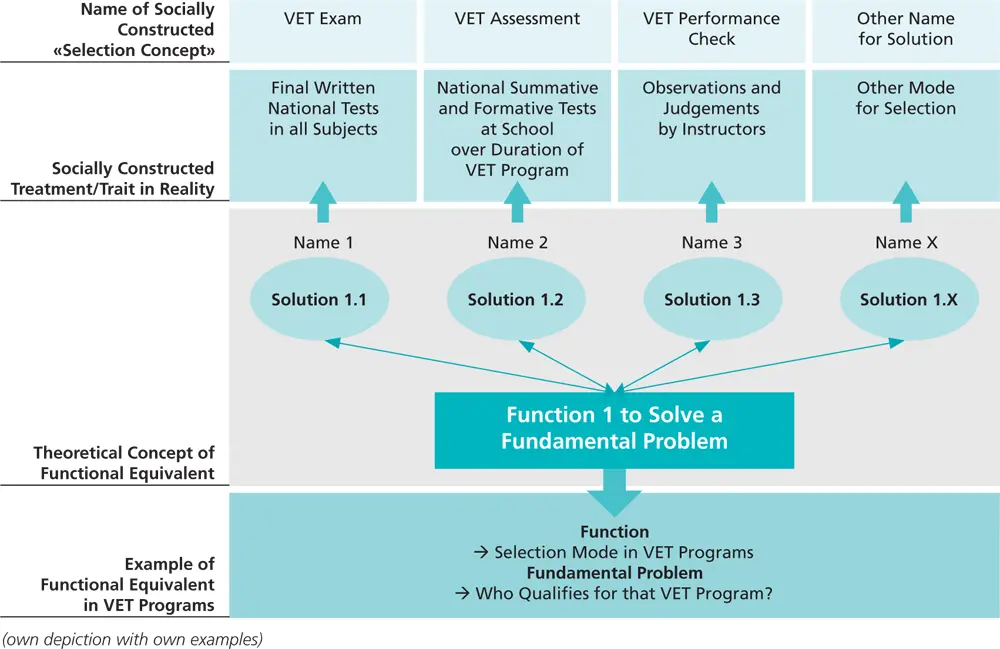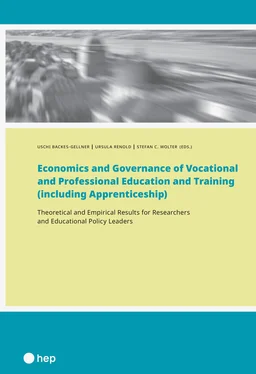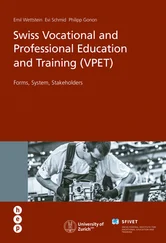Rageth and Renold (2019)have shown how the function of coordinating actors from the education and employment system through a VET process can take on different forms in the curriculum design, application, and feedback phases and can thus be used to develop a theoretically based typology of VET programs. The coordination function in the individual countries that are included in the comparison can take on very different forms, as the KOF Education-Employment Linkage Index studies have shown (Renold et al., 2015, 2016, 2017). Furthermore, Rageth (2018)shows that different empirical types of such coordination exist.
2.5.1 Functional Equivalents in Different Scientific Disciplines
In an intercultural context, the problem of socially constructed concepts is highly specific because the questions of what exactly can be the subject of comparisons and how aspects of social reality can be discovered or queried are not trivial. As Brandl-Bredenbeck (1999) briefly stated, “[t]his concerns the comparability of the object of investigation, the comparability of socio-cultural framework conditions, the comparability of the tools and the comparability of the group being studied” (p. 68[14]). Brandl-Bredenbeck summarized the relevant literature and showed that, in international comparative studies, a distinction is made among functional, conceptual, linguistic, metric, and sample equivalence (1999, p. 68). It is a fact that the topic of the social construction of objects of investigation has already been widely discussed in the social sciences (Matthes, 1992; Grollmann, 2008; Brockmann et al., 2009). However, the topic seems to have found little resonance with regard to VET programs.
Hoelliner and Eder (2016) took the example of the construct of religion to show the challenges that must be faced when testing functional equivalences and the validity of religious indicators in international comparative surveys. Schweiwe (2000) used examples to explain what a functional equivalent is in comparative law. He refers to Pound (1936), who describes the essence of functional comparative law as follows:
…how the same things may be brought about, the same problem may be met by one legal institution or doctrine or precept in one body of law and by another and quite different institution or doctrine or precept in another. (p. 59)
DiFrisco (2017) transferred the theory to the field of biology and showed how functional explanations in biology are threatened by functional equivalences. To explain the feature’s prevalence by its function, the function would have to explain why exactly this feature is widely used instead of a different, functionally equivalent feature.
Finally, personnel economics has addressed issues of functional equivalents. Black (2007) discussed the role of national culture in his theory of comparative industrial relations and referred to other scholars in his discipline who spoke of equivalent concepts . Among other aspects, Black also addressed the variety of capitalism analysis that emerged from the theory of neo-institutionalism. He noted that
the (…) review of systems theory, the Marxist critique, strategic choice theory and neo-institutionalism has highlighted two points. First, none of these theories of national difference has been confirmed by hypothesis testing. Second, with the exception of Meltz’s (1993) amended systems model and Poole’s (1986, 1993) strategic choice model, they all largely ignore the role of national culture. (Black, 2007, p. 1142)
Backes-Gellner (1996) discussed the importance of functional equivalences in comparing relevant institutions and their function in the VET systems of the UK and Germany. In so doing, Backes-Gellner referred to Blanpain’s (1987) approach and developed a functional comparison between VET aspects of Germany and the UK. The concept of the external examination , according to the German Vocational Training Act (art. 40, para. 2), is functionally equivalent to the Accreditation of Prior Learning (APL) in the UK (Backes-Gellner, 1996, p. 148).
This latter example can be illustrated by using the functional equivalence approach developed by DiFrisco (2017) to better understand how to operationalize functional equivalents. Functional equivalents can be seen as distinct traits that have the same function (DiFrisco, 2017) . Hence, two characteristics are functional equivalents if they do not belong to the same trait type but have the same function. “Trait T has the function F in country x under conditions Cn if T’s performing F in x under Cn contributes to attaining the goal G” (DiFrisco, 2017, p. 2). This formula is applied in the following two examples in the social field of VET.
Table 3: Functional Equivalents—Comparison of the UK and Germany
| Functional equivalence |
External examination |
Accreditation of prior learning |
| Treatment or Trait T |
T 1External examination |
T 2Recognition of learning achievement as a form of examination |
| Function of T = F |
Selection[15] |
Selection |
| Country = X |
Germany |
United Kingdom |
| Conditions Cn(internal, external conditions) |
•At least double the time prescribed as a training period spent working in the profession in which the candidate wants to take the examination.•This can be waived if it can be credibly demonstrated or otherwise shown that the candidate has acquired knowledge and skills justifying admission to the examination (Backes-Gellner, 1996, p. 148). |
•A personal report by the candidate.•Products of past work (which could include budgets, proposals, plans, and publications).• Letters of validation, for example, from a client or third party.•The product of an interview in which specific oral/written questions are answered.•Tasks that have been specially set by the APL center (to cover where evidence may be unavailable or lost) (Backes-Gellner, 1996, p. 108). |
| Goal G |
Acquisition of a professional degree. |
Acquisition of a national vocational qualification (NVQ) degree. |
(own depiction, translation by author)
As the example shows, equivalence analyses of this nature are suitable for addressing the social construction of concepts by means of clearly empirically verifiable features. However, there are also limits to this approach. In the example, both treatments lead to the acquisition of a VET qualification via the function of selection . However, for example, this functional equivalent does not say much about the breadth of the skills that have been acquired. It is also unclear whether the National Vocational Qualification (NVQ) degree in the UK is recognized by the education authorities.
Figure 2builds on the previously developed theoretical concept step and adds the levels where values, beliefs, attitudes, and sociocultural regulations make the functional equivalent a socially constructed concept (see top two levels in fig. 2). In the words of Luhman (2010), “[…] problems and problem-related functional equivalences are not only generated by academic theory, but are already present in social reality itself” (p. 17[16]).

Figure 2: Functional Equivalent Represented as Socially Constructed Concepts
2.5.2 Static versus Dynamic Functions
Luhmann pointed out that the relationality of fundamental relationships is always contingent and connected to a temporal and factual aspect (Luhmann, 2010). Therefore, the functional equivalent examples of external examinations and accreditation of prior learning by Backes-Gellner (1996) can be interpreted differently today because the education systems have been functionally differentiated.
Читать дальше













